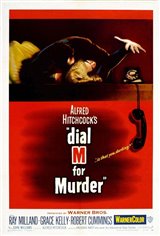Dial M for Murder
Quintessential cool blonde (and Hitchcock favorite) Grace Kelly stars as a society woman around whom jealous husband Ray Milland arranges the perfect murder. But thanks to a well-placed pair of scissors, the tables are turned and Milland's carefully-laid plans begin to disintegrate. Hitchcock used a rapid 36-day shooting schedule, and was dismissive of 3-D itself ("A nine-day wonder, and I came in on the ninth day"). He refused to open out the hit play by Frederick Knott (author of another masterpiece of unknown terror, Wait Until Dark), confining the action except the determinedly unrealistic trial scene to one set, and setting his cameras in a pit to get low-angle shots designed to empha depth and giving the film a theatricality and claustrophobia à la Rope and Rear Window, only on this stage the proscenium doesn't end at the screen, it extends into the audience. 3-D is most effectively used in the murder sequence, which takes on new and greater significance as the viewer is placed in the midst of the struggle: a voyeuristic accomplice to murder as only Hitchcock could have planned.
| Director: | Alfred Hitchcock |
| Producer(s): | Alfred Hitchcock |
| Cast: | Leo Britt, Patrick Allen, George Leigh, George Alderson, Robin Hughes |
| Writer(s): | Frederick Knott |



